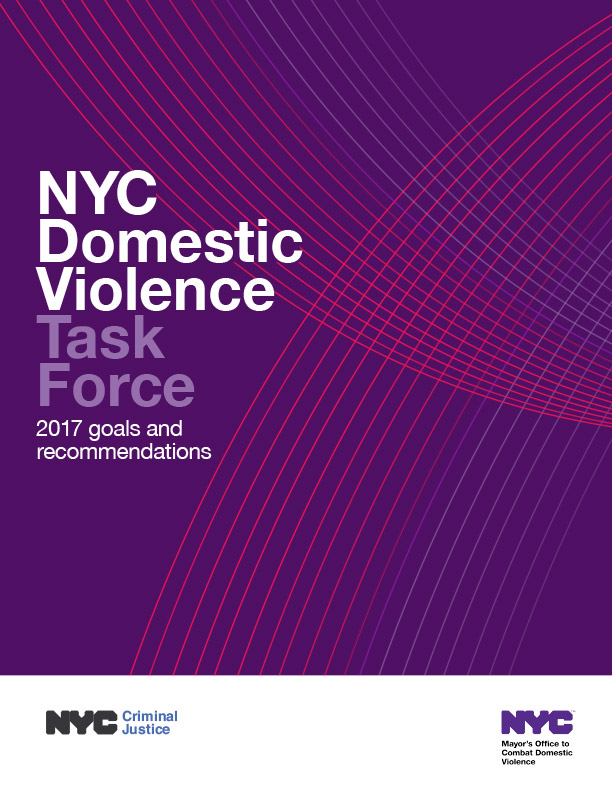Domestic Violence Task Force 2017 Goals and Recommendations
Since 1990, rates of violent crime in New York City have decreased by more than 75%—a dramatic decline that has made New York City one of the safest big cities nationwide But, over the past ten years, complaints of felony and misdemeanor domestic violence offenses have increased and now represent a growing percentage of crime citywide.
In 2007, 4.8% of all major crimes in the City were related to domestic violence (broadly defined to include offenses involving members of the same family
or household as well as those related to intimate partners). By 2016, that percentage had reached 11.6%. Domestic violence now accounts for one in every five homicides—and two in every five reported assaults—citywide.
This is a troubling trend. Even more troubling is the larger universe of domestic abuse that goes unreported every year. A leading national study found that 5.4% of individuals in the United States over the age of 18 are victims of rape, physical assault or stalking by an intimate partner annually. If this rate holds true here in New York City, then nearly 352,000. New Yorkers are victimized by an intimate partner every year, substantially more than the number of intimate partner violence complaints made to police.
What this tells us is that domestic violence is an insidious problem that often hides behind other problems. It is a problem that has far-reaching impact on our families, our communities and our City: nearly 25% of New York City shelter admissions are due to domestic violence; 20-40% of chronically violent adolescents have been exposed to extreme parental conflict at home; and women who experience physical violence from an intimate partner report an average of 7.2 days of lost work-related productivity a year.
The persistence of domestic violence even as the City has become safer overall led Mayor Bill de Blasio in November 2016 to create the NYC Domestic Violence Task Force. Co-chaired by First Lady Chirlane McCray and Police Commissioner James O’Neill, and operating with guidance from the Mayor’s Office of Criminal Justice and the Mayor’s Office to Combat Domestic Violence, the Task Force was charged with reenvisioning how New York City responds to domestic violence. The Mayor praised it as “unique in its focus on bringing law enforcement and social services together to look with fresh eyes at how we can both hold abusers accountable and ensure that we are providing smart and effective pathways to safety for survivors.”
The Task Force members included experts and leaders from a broad spectrum of City agencies and community-based organizations, professionals who assist victims and work with offenders, leaders in law enforcement and the criminal justice system, senior representatives from key City agencies, and individuals who have survived domestic violence. The Task Force members’ collective knowledge is critical to understanding domestic violence here in New York City—both the nature of the problem and the strengths and weaknesses of our current responses—and to identifying critical service needs and areas for improvement.
Based on their expertise, Task Force members joined one of four working groups charged with identifying effective strategies to advance the following goals: prevent violence and abusive behavior before it happens; increase early reporting and engagement by survivors; enhance the response of the criminal justice system; and create strategies for long-term violence reduction and innovative practices to hold offenders accountable.
Staff from the Mayor’s Office of Criminal Justice and the Mayor’s Office to Combat Domestic Violence, with assistance from the City University of New York Institute for State and Local Governance, gathered a wealth of current information, including statistics on domestic violence complaints to police and criminal case outcomes, data on shelter and social service involvement of victims and abusers, and research on promising models for combating domestic violence that are in use either in New York City or elsewhere in the country. As part of the knowledge gathering process, the Mayor’s Office to Combat Domestic Violence also surveyed 26 city agencies and 84 community- based organizations about their domestic violence-related practices and services.
Task Force members worked intensely over the course of six weeks in early 2017 to identify existing domestic violence programs and interventions that are working well, those that need attention and promising practices that could be implemented or expanded. As their work progressed, the Task Force members held supplemental meetings to further explore how domestic violence cases are handled in the family and criminal court systems and to discuss ways to facilitate data collection and reporting between agencies. Meetings with elected officials were held to inform them of the Task Force’s progress and to solicit their feedback and ideas.
The result is a set of recommendations for targeted investments to create durable and effective solutions to domestic violence citywide. Collectively, these recommended investments offer fresh, comprehensive strategies for:
1. Expanding child and youth prevention and intervention;
2. Enhancing criminal justice system responses;
3. Strengthening New York City communities; and
4. Improving citywide coordination to maximize resources.



